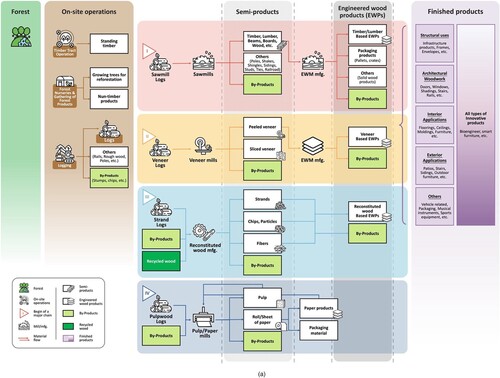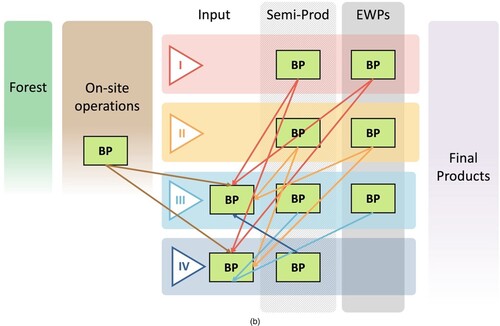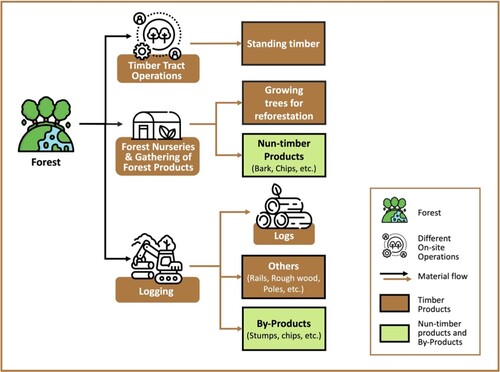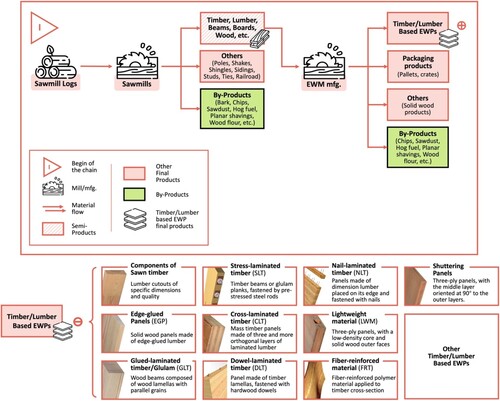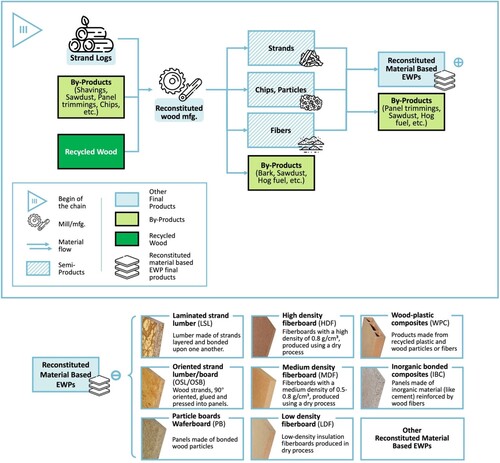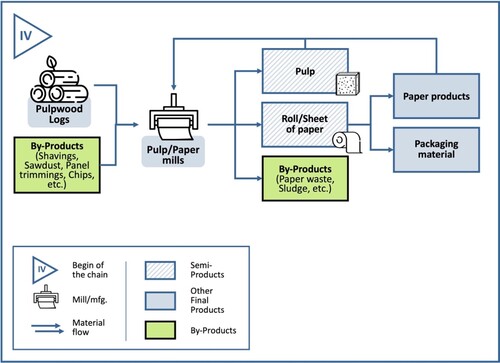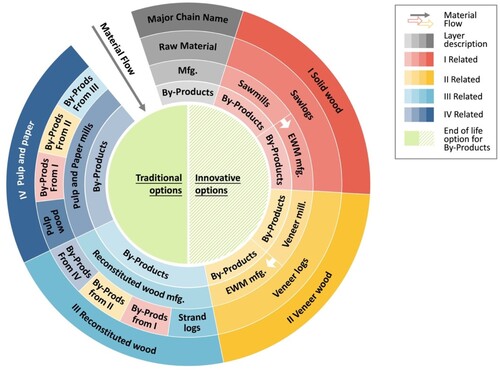ABSTRACT
With the increasing importance of wood as a sustainable material and addressing challenges facing the wood products industry, there is an emerging need for innovation and collaboration across all industry sectors. The mapping of the wood products industry has become crucial for gaining an overview and overall understanding of material flow. It also proved beneficial for educational and research purposes. The outcome of this study should help seek new economic opportunities and promote sustainable resource management. A Generic Map was developed to navigate the entire wood products industry as well as Dive-in Chain Maps will guide the four major production chains: sawmill (I), veneer mill (II), reconstituted wood manufacturing (III), and pulp and paper mills (IV). In addition, a By-products Management Wheel Diagram was introduced to clarify waste management practices within these chains. Our approach sheds light on efficient material flow and utilization, revealing opportunities for innovation and the development of high-value products. It also offers strategies for minimizing waste and making informed end-of-life decisions. Ultimately, this study enhances the understanding and potential for circularity and sustainability in the wood products industry.
1. Introduction
With the increasing global focus on sustainability, the significance of wood as carbon sequestering and future building material for our societies is becoming more evident (Leskinen et al. Citation2018, Johnston and Radeloff Citation2019, Churkina et al. Citation2020, Green and Taggart Citation2020, Pramreiter et al. Citation2023). In the last decade, wood-products manufacturers have faced challenges, such as a decline in the qualified labor force (Woodall et al. Citation2011), inconsistencies in material availability in some regions of the world, evolving product preferences, and industry transformation (Toivonen Citation2012, Luppold and Bumgardner Citation2016). Fostering growth and evolution in the wood products industry requires innovation paired with inter-industrial collaboration. Therefore, it is crucial to thoroughly comprehend the universal supply chain for wood products and its cascading aspects. Industry mapping is an effective method for acquiring these insights and is highly beneficial for educational and research purposes.
Substantial efforts have been made to map the industry, especially in Europe. Various maps have been developed: In Germany, researchers have collectively mapped the logistic network for wood flow, efficiency of wood cascade chains, and the reuse as well as cascading potential of recovered wood from building deconstruction (Höglmeier et al. Citation2013, Taskhiri et al. Citation2016, Risse et al. Citation2017, Szichta et al. Citation2022). Dynamics of the wood supply chain in France were first charted by Lenglet et al. (Lenglet et al. Citation2017), while Straže's team mapped the value chains in Slovenia's forest-wood sector to enhance circular economy practices (Straže et al. Citation2023). Mehr's team looked into environmentally optimal wood utilization patterns in Switzerland under varying wood cascading options (Mehr et al. Citation2018), while Hekkert et al. analyzed and mapped paper and wood flow in the Netherlands with the STREAMS method (Hekkert et al. Citation2000). Bridging national studies to a pan-European scale, Teischinger surveyed and mapped the European hardwood area and its allocation to various wood process chains (Teischinger Citation2017). Bringing a focus to environmental concerns, Bais-Moleman et al. assessed the potential of cascading use of woody biomass for GHG emission reduction across Europe (Bais-Moleman et al. Citation2018), highlighting the region's commitment to sustainable resource management.
These mapping efforts, characterized by their meticulous detail and comprehensive coverage, have significantly contributed to our collective understanding of regional dynamics. However, there is still room for a more generalized map that can cater to a broader audience (including educators, architects, designers, and the interested general public) and serve as a clear and unified starting point for those seeking a broader perspective.
Considering those established works, our endeavor is not a replacement but an abstraction. We aim to extract and synthesize the foundational elements, underlying structures, and critical components inherent in these region-specific maps. Based on material flow analysis in the wood industry by volume (Mantau Citation2012, Citation2015, Höglmeier et al. Citation2015, Lenglet et al. Citation2017) and the cascading use of wood to improve resource efficiency (Höglmeier et al. Citation2013), we aim to develop a generic simplified map that offers a more encompassing view of the wood products industry and its most significant production/value chains. Based on this simplified map, one should be able to:
develop understanding and make informed decisions about material flow and utilization,
spot potential areas for industry innovation and focus on developing high-value-added products,
identify opportunities to minimize waste and make early-stage end-of-life options (EOLO) decisions, and
understand and integrate principles of circularity and sustainability.
2. Methodology
2.1. Literature review
This study explores the feasibility of making a cascading map for the current wood-products industry to review the status quo. It examined peer-reviewed articles published or in the state of »in press« in international peer-reviewed scientific journals. Publications pertinent to the wood products supply chain were reviewed. The literature of the following keywords in Web of Science, Scopus, and Google Scholar, including Cascade/cascading, Life Cycle Assessment (LCA), Material Flow Analysis (MFA), and Circular bioeconomy in combination with Wood, Flow, Forest, Products, Use, Engineered/Engineering Wood Products (EWPs), Chains were screened.
Before the systematic literature review, search terms were identified using previous literature and the expert knowledge of the researchers involved in this study. Because the information we were interested in was sometimes not in article titles, keywords, or abstracts, additional articles cited in the initial list of articles were searched for to find publications undetected through the first search. The final analysis included monographs in the field, peer-reviewed journals, conference proceeding, United Nations reports, industry association reports, governmental database, and consultation with industry representatives, association officials, and researchers. Searches were conducted with no date limits and ranged through the end of 2023.
2.2. Industry visualization
The study’s goal was to visualize the overall wood products industry through easy-to-navigate maps that are comprehensive and usable by a broader audience, from students to wood products producers and users. A serie of maps with varying levels of complexity was developed, which aided in the analysis. The images used were obtained from the authors’ photo collections and taken by the authors. Infographics were obtained from the public domain. Wood-products experts reviewed and adjusted maps. They will serve as the base for future innovative work in this area.
3. Results and discussion
3.1. The generic map
A generic map that outlines the journey of wood products from the forest to the consumers was created (-a). This map was divided into four major segments: (1) Forest, (2) On-site operations, (3) Major chains, and (4) Finished Products. The Forest stage represents the origin of resources, where industries extract the raw materials through various on-site operations. Subsequently, in the form of logs, wood enters the manufacturing process.
Figure 1. A generic map of wood products from the forest to the consumers: a) an overview of generic wood-product value chains in graphical form, and b) by-products’ flow on the generic map.
The literature review guided the selection of four major chains: I Sawmill, II Veneer Mill, III Reconstituted Wood Manufacturing, and IV Pulp and Paper Mill. These chains are selected for their comprehensive representation of the wood products industry, significant economic impact, and diverse range of end products. Each chain was crucial in processing and using wood, playing a vital role in the industry's revenue, employment, and global trade dynamics.
In each chain, the ‘Semi-products’ section captures the transformation of wood into intermediate forms such as sawn wood (I), veneer (II), strands, chips and fibers (III), and pulp and paper (IV). The following explains how the ‘Engineered Products’ incorporated advanced technology to produce sophisticated products, including engineered wood products (EWPs). The ‘Finished Products’ category showcased the most value-added applications, ranging from traditional uses like structural, architectural, interior, and exterior applications to innovative products like biogenic materials and smart furniture.
By-products generated at each stage are highlighted in green, and the output of one process has the potential to become the input for another (-b). Overall, this map visualizes the product flow and shows the potential for efficiency, sustainability, and feasibility of circularity within the industry.
3.2. Dive-in chain maps
3.2.1. On-site operations
Before the initiation of the four major production chains, there were also industries operating in the forest, such as Timber Tract Operations, Forest Nurseries, and Gathering of Forest Products and Logging. The flow of these operations is shown in as on-site operations.
Timber tracts refer to those areas where standing timber is cultivated, managed, or sold (Brown et al. Citation2012, NAICS Citation2022). Timber Tract Operations encompass establishments, primarily operating timber tracts, to sell standing timber. These establishments involve timber cultivation, timber stand improvement, forest fire prevention, and firefighting.
Forest Nurseries and Gathering of Forest Products includes establishments primarily dedicated to two key activities: 1) cultivating trees for reforestation purposes and 2) gathering non-timber forest products, such as gums, barks, balsam needles, rhizomes, fibers, Spanish moss, ginseng, and truffles (Duryea et al. Citation1984, NAICS Citation2022).
Logging is usually engaged in one or more of the following: 1) cutting timber, 2) cutting and transporting timber, and 3) producing wood chips on-site. Logs harvested from the forest are transported to various mills and manufacturing facilities, initiating their journey within the production chains (NAICS Citation2022).
3.2.2. I: Sawmill – sawn-timber based EWPs
Sawmills are operations where logs are processed and integrated into supply chain I, shown in . After harvest, logs are transported from the forest to the sawmill by trunk or other means (Oneil and Puettmann Citation2017, Oneil Citation2021). Upon arrival, these logs are stored in a log yard until they're ready for processing. Before Primary breakdown, logs are often debarked and then cut into initial rough sizes to maximize the yield of usable wood (Todoroki and Rönnqvist Citation1999, Shmulsky and David Citation2019). After primary processing, sawn timber may only need cutting to width (edging) and length (trimming). However, many mills require a Secondary breakdown to convert cant and slab into boards (Smulski Citation1997). After that, products are categorized by size, type, and quality and subsequently stacked for drying. Post-drying, sawn timber might undergo further planning to ensure a smooth surface or treatment with preservatives to enhance durability.
A sawmill can produce a variety of wood products (Ramage et al. Citation2017, Shmulsky and David Citation2019). The primary output typically includes: 1) Sawn timber: the principal product of a sawmill. Depending on the intended use and log quality, sawn timber can be processed in various sizes and grades. 2) Main yeild of sawn timber/planks: the larger pieces of wood often used for structural purposes in construction. They are thicker and wider than standard lumber. 3) Boards (side boards): thinner than planks and often used for shelving, paneling, or flooring applications. These products are subsequently directed to engineered wood members (EWMs) manufacturers and wood treatment facilities. Durable cold-setting waterproof-structural adhesives such as phenol-formaldehyde (PF), phenol-resorcinol formaldehyde (PRF), emulsion polymer isocyanate (EPI), and polyurethane (PUR), are applied to enhance products’ durability and performance. Consequently, these treated products are made into sawn-timber-based EWPs and other solid-wood products.
Sawn-timber-based EWPs represent substantial progress in global wood processing. They were created to deal with the materials’ inhomogeneity and anisotropic behavior, enhancing their suitability for various residential and commercial construction applications (Sotayo et al. Citation2020). This enhancement allows for the developing of innovative construction designs (Kitek Kuzman et al. Citation2018, Salvadori Citation2021). As illustrated in , notable sawn-timber-based EWPs include components of sawn timber, edge-glued panels (EGP), glued-laminated timber (GLT), stress-laminated timber (SLT), cross-laminated timber (CLT), dowel-laminated timber (DLT), nail-laminated timber (NLT), light-weight material (LWM), fiber-reinforced timber (FRT), and shuttering panels (Williamson Citation2002, Ong Citation2015, Crocetti et al. Citation2016, Sandberg et al. Citation2018, Massaro and Malo Citation2020, Sotayo et al. Citation2020, Kasal and Yan Citation2021, Niemz et al. Citation2023).
3.2.3. II: Veneer mill – veneer-based EWPs
The veneer-production chain II () begins with raw-material selections. The manufacturing uses softwoods and hardwoods, with the choice based on the intended use and the availability of logs with suitable shapes and sizes. The process of conditioning the log may precede (Hughes Citation2015) or follow debarking (Shi and Walker Citation2006), depending on the method. Conditioning generally involves heating the logs through soaking or steaming to make them more pliable, facilitating the subsequent slicing or peeling (Lutz Citation1978). Logs are placed on a lathe for peeling, or a slicing machine based on their quality, size, and intended uses. After production, veneer sheets might be trimmed to achieve uniform sizes and to remove defects. They are then dried to lower their moisture content, making the veneers more suitable for gluing and hot pressing. The dried veneer sheets are then sorted by size, quality, and other criteria before being stacked for further processing or sale.
Sliced and peeled veneer sheets are the major semi-products of the veneer mills. Both of them have a wide range of applications in various industries. The use of adhesive is vital to transform these veneers into products. Phenol formaldehyde (PF) is the most commonly used adhesive system in veneer-based panel manufacturing. This thermoset adhesive, which cures by heating, provides a waterproof and irreversible bond between the veneers. Sliced veneer is often chosen for its decorative qualities, finding uses as a surface layer for complete materials for producing furniture, cabinetry, and musical instruments. Peeled veneer is commonly transformed into veneer-based EWPs for structural purposes such as plywood (PW), mass-plywood panels (MPP), laminated veneer lumber (LVL), laminated veneer products (LVP), high-pressure laminated veneer (HPLV), and parallel strand lumber (PSL) (Sandberg et al. Citation2018, Shmulsky and David Citation2019, Miyamoto et al. Citation2020, Slabohm et al. Citation2022).
3.2.4. III: Reconstituted wood manufacturing – reconstituted wood-based EWPs
The III reconstituted wood manufacturing process () begins with wood-based raw materials, sorted by size: Strand, Chips and Particles, and Fibers. Strands are long, slender wood pieces produced from debarked logs. In North America, species such as aspen, southern pine, spruce, birch, yellow poplar, sweetgum, sassafras, and beech are the primary sources of strands (Forest Products Laboratory Citation2021). Chips are smaller pieces of wood, often derived from sawmill by-products or the chipping of low-quality logs. Particles are even smaller, resembling coarse sawdust, and are often utilized in particleboard production. At the same time, Fibers are the finest wood material listed, commonly derived from manufacturing by-products, recycled wood, or sawdust, thus promoting material utilization (Gong Citation2022).
Once the appropriate wood material is selected, structural adhesive and sometimes wax will be applied. Urea-formaldehyde (UF), Melamine urea formaldehyde (MF), Phenolic resins (PF), and 4,4-diphenylmethane diisocyanate (MDI) are most commonly used, sometimes in conjunction with wax. The choice of adhesive is contingent upon the specific reconstituted wood product being manufactured (Ansell Citation2015, Gong Citation2022, Niemz et al. Citation2023). The wood, combined with the adhesive and wax, is formed into mats or billets, pressed to achieve the required thickness and density. The finishing phase includes cutting to size, sanding for smoothness, and optionally laminating for enhanced durability or aesthetic appeal (Shmulsky and David Citation2019, Gong Citation2022).
The comprehensive process yields Reconstituted wood-based EWPs, including strands-based products like laminated strand lumber (LSL), oriented-strand lumber/boards (OSL/OSB), chip, and particle-based products such as particleboards (PB) or waferboards (WBs); and fiber-based high-density fiberboard (HDF), medium-density fiberboard (MDF), low-density fiberboard (LDF) (FAO Citation2022). The semi-products from reconstituted wood manufacturing may be combined with other materials to create composite EWPs, like wood-plastic composites (WPCs) and inorganic-bonded composites (IBCs) (Sandberg et al. Citation2018). The engineered design of all these wood products allows them to utilize materials that would otherwise be burned for energy or relegated to landfills as waste. Over time, these products have undergone significant evolution, transforming into highly sophisticated solutions tailored to meet specific needs. They have shown to be versatile in modern construction, furniture design, and other various applications where traditional solid wood might not be optimal for particular purposes and cost-efficiency.
3.2.5. IV: Pulp and paper manufacturing – paper products and packaging material
The IV, pulp and Paper production () mainly involves transforming fibrous raw material into pulp and then converting pulp into paper. Wood is composed of cellulose, lignin, hemicelluloses, and extractives. Approximately 50% of wood’s oven dry weight is cellulose. This component is particularly significant in the production of paper pulp. During the processes, both hardwoods and softwoods are included as the longer fibers provide strength to the paper, while the shorter fibers of hardwoods enhance their smoothness (Bajpai Citation2018).
At the pulp mill, the initial process is debarking the logs to ensure a clean surface for pulping. Once debarked, the logs are chipped into small, uniform pieces, increasing the surface area for the subsequent pulping process. By-products from other mills can be used. The pulping process separates the fibers from an unsuitable fraction of the wood, the lignin. Hemicelluloses is crucial for ensuring fiber-to-fiber bonding in paper making. Pulp making can be achieved chemically, like the kraft or sulfite process, or thermo-mechanically. The resulting pulp might undergo bleaching if a whiter, brighter pulp is desired (Bajpai Citation2018, Shmulsky and David Citation2019, Niemz et al. Citation2023). Once prepared, the pulp gets transported to a paper mill or is directly fed into an integrated paper production line within the same facility. The pulp is diluted with water at the paper mill and often refined to improve its paper-making properties. It's then spread onto a paper machine where water is removed through screens by pressing and drying. The final process, finishing, is performed in-line at the end of the paper machine or off-line after the paper machine. Finishing covers the processes of sizing, coating, reeling, calendaring, winding, sheeting, and roll handling, depending on the desired properties and end-use of the paper (Bajpai Citation2018).
The primary products of the paper mill are vast rolls or sheets of paper (king rolls), which can be further converted into a myriad of products, from writing paper to packaging materials. The versatility of paper products lies in their adaptability – they can be tailored for strength, brightness, opacity, and other specific attributes based on requirements (Bajpai Citation2018, FAO Citation2022).
3.3. By-products management wheel diagram
The cascading use of wood embodies a transformative approach to resource efficiency and waste management within the wood industry. It was conceptualized in 1994 (Sirkin and Houten Citation1994) and has evolved into a model defined as the efficient utilization of resources by using residues and recycled materials for material use to extend total biomass availability within a given system. Following this definition, cascading use is centered on employing high-quality raw materials for high-value products and utilizing the degraded forms of these materials in lower-value applications throughout their lifespans (Mair and Stern Citation2017, Lokesh et al. Citation2018).
In the circular economy context, wood is treated as a resource that should retain its structural integrity across as many uses as possible (FAO Citation2021). The goal is to extend the life of wood products through multiple reuse, recovery, and recycling loops, maximizing their utility and efficiency ().
The Chain I (Solid wood) generated by-products such as barks, chips, sawdust, hog fuel, planar shavings, and wood flour. The bark undergoes grinding to be either sold or utilized as fuel. Sawdust, produced from sawing, is sold, or used as a combustible material. Slabs, edgings, and trimmings, deemed too small for sawn-timber production, are converted into chips, and then supplied to pulp mills. Hog fuel, in turn, is either commercialized or serve as feedstock for on-site boilers (Puettmann et al. Citation2017, Puettmann Citation2019, Shmulsky and David Citation2019).
In Chain II (Veneer wood), similar by-products are produced. These include barks, peeler cores, veneer downfalls, veneer clippings, lay-up scraps, panel trimmings, sawdust, and hog fuel. Peeler cores can be sold for fence posts or to a small stud mill to be processed into sawn timber. Downfalls, clippings, lay-up scraps, and panel trimmings can be collected pneumatically into a collection system (e.g.: baghouses) and used as wood fuel to produce heat for thermal energy-intense processes drying and hot pressing or sold (Hughes Citation2015, Puettmann et al. Citation2016b, Bergman and Alanya-Rosenbaum Citation2017).
In Chain III (Reconstituted wood), strand-based materials share processes with products in chains I and II, starting from logs. It generates by-products like barks, panel trimmings, sawdust, and hog fuel. Particle-based and fiber-based boards, integral to this chain, are designed initially to utilize industrial wood by-products—including recycled wood, wood shavings, sawdust, panel trimmings, and chips. These boards and panels can be produced from logging by-products or directly from trees, transforming them into new products (Puettmann et al. Citation2016a, Citation2018, Citation2019, Shmulsky and David Citation2019).
Chain IV (Pulp and Paper), typically start with pulping chips sourced from pulp logs, mentioned in previous chains, and alternative sources like construction waste in regions where wood is costlier. The by-products generated during this phase include paper waste and sludge, which result from the process of converting these chips into pulp and subsequently into paper products (Bajpai Citation2015).
As shown in , by-products are crucial secondary resources. Material such as wood chips from chains I and II feed into chains III and IV, fostering the production of engineered wood and paper products. Even finer particles and paper wastes are recycled, contributing to manufacturing particle-based EWPs, fiber-based EWPs, and new paper products.
Currently, the transition of the wood industry towards a circular economy faces obstacles, including the low value of by-products and the substantial costs of transporting them. Most by-products find their way into energy production through incineration, which, while beneficial, may not fully leverage their potential for circularity. The primary strategies for managing these by-products—energy incineration, biofuel conversion, and repurposing for uses like landscaping or animal bedding—present a foundation for further development.
Despite the efficient use of resources through cascading and recycling, inevitably, there will be residual waste. The most significant among these final waste products are boiler ash and some non-combusted wood scraps, traditionally seen as the end-line by-products with minimal utility or value. Innovation is needed to find new uses for these materials, thus minimizing waste and furthering the sustainability of the industry’s circular economy.
Innovative end-of-life options and designs are crucial for enhancing the circular use of by-products and waste stages. Developing new uses for these materials and increasing their economic value are essential for a more sustainable and efficient circular economy. This calls for a concerted effort in innovation, encompassing product design, recycling technologies, and waste management strategies, to minimize waste and maximize the utility of all wood resources. In this vein, recent innovations have transformed fine particles into materials suited for 3D printing (Kromoser et al. Citation2022) and smart packaging. These advancements exemplify the industry's dedication to exploring new, sustainable methods of resource utilization, seamlessly blending technological innovation with environmental stewardship.
4. Conclusions
The Generic Map, Dive-in I – IV Chain Maps, and By-products Management Wheel Diagram developed in this study are envisioned as foundational tools for sustainable process planning and innovation in the wood-products sector. These tools have the potential to influence future developments and applications in various ways:
Understanding of industry overview for all stakeholders: Primary stakeholders are those without whose continuing participation the company would not survive (i.e. shareholders, employees, customers, suppliers, and the government), and secondary stakeholders are groups of people without direct transactions with the company but otherwise affected by it (e.g. communities, competitors, and the media) (Lähtinen et al. Citation2017). The industry map could help stakeholders to understand the extent and limitations of the forest products sector and visualize the product lifecycle from resource to final product.
Decision-making and process improvement: By utilizing these maps, stakeholders can make more informed decisions about material utilization or refining production processes. Decisionmakers could also see the future opportunities for industry innovation, sustainability, and value-adding.
Evaluating circular economy applications: The maps provide a framework to assess efficiency, identify potential gaps, and recognize opportunities for applying circular economy principles. They guide companies looking to integrate sustainability into their business models, helping them adopt economically viable and environmentally responsible practices.
Innovation in sustainable material production: These tools will play a crucial role in rethinking the production of innovative materials. The maps guide efforts towards a sustainable future, particularly in building and environmental applications, by focusing on zero waste and developing renewable and recyclable products.
Inspiration for product developers, engineers, architects, and designers: The maps can inspire the creation of new products, inform about the origins of materials, and foster connections with other industry sectors. Maps should bring their users a deeper understanding of material variability and promote a more sustainable approach to design and architecture.
The generic map is poised to achieve circularity for wood and its expansion into new areas of potential value-adding. For instance, a case study focusing on hardwood products in the U.S. hardwood region could further demonstrate the utility of these tools. Such expansions will continue to explore and exploit new opportunities, enhancing the industry's capacity for sustainable growth and innovation.
Acknowledgments
This study was supported by the Department of Forestry and Natural Resources at Purdue University, USA; the Slovenian Research Agency, Program P4-0015, P4-0059; and Bilateral project BI-US/22-24-043.
Disclosure statement
No potential conflict of interest was reported by the author(s).
References
- Ansell, M.P., 2015. Wood composites. Woodhead Publ. doi:10.1016/C2014-0-02700-1.
- Bais-Moleman, A.L., et al., 2018. Assessing wood use efficiency and greenhouse gas emissions of wood product cascading in the European union. Journal of Cleaner Production, 172, 3942–3954. doi:10.1016/j.jclepro.2017.04.153.
- Bajpai, P., 2015. Management of pulp and paper mill waste. Springer International Publishing. doi:10.1007/978-3-319-11788-1.
- Bajpai, P., 2018. Biermann’s handbook of pulp and paper. Elsevier. doi:10.1016/C2017-0-00513-X.
- Bergman, R.D. and Alanya-Rosenbaum, S., 2017. CORRIM Report: Life Cycle Assessment for the Production of PNW Laminated Veneer Lumber.
- Brown, R.N., et al., 2012. The impact of timber-sale tract, policy, and administrative characteristics on state stumpage prices: An econometric analysis. Forest Policy and Economics, 21, 71–80. doi:10.1016/j.forpol.2011.10.001.
- Churkina, G., et al., 2020. Buildings as a global carbon sink. Nature Sustainability, 3 (4), Article 4. doi:10.1038/s41893-019-0462-4.
- Crocetti, R., Ekholm, K., and Kliger, R., 2016. Stress-laminated-timber decks: state of the art and design based on Swedish practice. European Journal of Wood and Wood Products, 74. doi:10.1007/s00107-015-0966-1.
- FAO, 2021. Circularity concepts in forest-based industries.
- FAO, 2022. Classification of forest products. FAO. doi:10.4060/cb8216en.
- Forest Products Laboratory, 2021. Wood handbook—wood as an engineering material (p. 543). Madison, WI: U.S. Department of Agriculture, Forest Service, Forest Products Laboratory.
- Gong, M., ed., 2022. Engineered wood products for construction. IntechOpen. doi:10.5772/intechopen.92960
- Green, M. and Taggart, J., 2020. Tall wood buildings: design, construction and performance. second and expanded edition. Basel: Birkhäuser.
- Hekkert, M.P., Joosten, L.A.J., and Worrell, E., 2000. Analysis of the paper and wood flow in The Netherlands.
- Höglmeier, K., et al., 2015. LCA-based optimization of wood utilization under special consideration of a cascading use of wood. Journal of Environmental Management, 152, 158–170. doi:10.1016/j.jenvman.2015.01.018.
- Höglmeier, K., Weber-Blaschke, G., and Richter, K., 2013. Potentials for cascading of recovered wood from building deconstruction—A case study for south-east Germany. Resources, Conservation and Recycling, 78, 81–91. doi:10.1016/j.resconrec.2013.07.004.
- Hughes, M., 2015. Plywood and other veneer-based products. In: Wood composites. Elsevier, 69–89. doi:10.1016/B978-1-78242-454-3.00004-4.
- Johnston, C.M.T. and Radeloff, V.C., 2019. Global mitigation potential of carbon stored in harvested wood products. Proceedings of the National Academy of Sciences, 116 (29), 14526–14531. doi:10.1073/pnas.1904231116.
- Kasal, B. and Yan, L., 2021. Fiber-Reinforced polymers as reinforcement for timber structural elements. In: J. Branco, P. Dietsch, and T. Tannert, eds. Reinforcement of timber elements in existing structures: state-of-the-Art report of the RILEM TC 245-RTE. Springer International Publishing, 51–78. doi:10.1007/978-3-030-67794-7_4
- Kitek Kuzman, M., et al., 2018. Architect perceptions of engineered wood products: An exploratory study of selected countries in Central and Southeast Europe. Construction and Building Materials, 179, 360–370. doi:10.1016/j.conbuildmat.2018.05.164.
- Kromoser, B., et al., 2022. Circular economy in wood construction – Additive manufacturing of fully recyclable walls made from renewables: proof of concept and preliminary data. Construction and Building Materials, 344, 128219. doi:10.1016/j.conbuildmat.2022.128219.
- Lähtinen, K., et al., 2017. Forest sector sustainability communication in Europe: a systematic literature review on the contents and gaps. Current Forestry Reports, 3 (3), 173–187. doi:10.1007/s40725-017-0063-2.
- Lenglet, J., Courtonne, J.-Y., and Caurla, S., 2017. Material flow analysis of the forest-wood supply chain: a consequential approach for log export policies in France. Journal of Cleaner Production, 165, 1296–1305. doi:10.1016/j.jclepro.2017.07.177.
- Leskinen, P., et al., 2018. Substitution effects of wood-based products in climate change mitigation (From science to policy). [From Science to Policy]. European Forest Institute, doi:10.36333/fs07.
- Lokesh, K., Ladu, L., and Summerton, L., 2018. Bridging the gaps for a ‘circular’ bioeconomy: selection criteria, Bio-based value chain and stakeholder mapping. Sustainability, 10 (6), 1695. doi:10.3390/su10061695.
- Luppold, W. and Bumgardner, M., 2016. U.S. hardwood lumber consumption and international trade from 1991 to 2014. Wood and Fiber Science, 48 (3), 162–170.
- Lutz, J.F., 1978. Wood veneer: Log selection, cutting, and drying. Charlottesville, VA: Department of Agriculture, Forest Service.
- Mair, C. and Stern, T., 2017. Cascading utilization of wood: A matter of circular economy? Current Forestry Reports, 3 (4), 281–295. doi:10.1007/s40725-017-0067-y.
- Mantau, U., 2012. Wood flows in Europe (EU27).
- Mantau, U., 2015. Wood flow analysis: quantification of resource potentials, cascades and carbon effects. Biomass and Bioenergy, 79, 28–38. doi:10.1016/j.biombioe.2014.08.013.
- Massaro, F.M. and Malo, K.A., 2020. Stress-laminated timber decks in bridges: friction between lamellas, butt joints and pre-stressing system. Engineering Structures, 213, 110592. doi:10.1016/j.engstruct.2020.110592.
- Mehr, J., et al., 2018. Environmentally optimal wood use in Switzerland—Investigating the relevance of material cascades. Resources, Conservation and Recycling, 131, 181–191. doi:10.1016/j.resconrec.2017.12.026.
- Miyamoto, B.T., Sinha, A., and Morrell, I., 2020. Connection performance of mass plywood panels. Forest Products Journal, 70 (1), 88–99. doi:10.13073/FPJ-D-19-00056.
- NAICS, 2022. NAICS Manual. https://www.census.gov/naics/reference_files_tools/2022_NAICS_Manual.pdf.
- Niemz, P., Teischinger, A., and Sandberg, D., eds., 2023. Springer handbook of wood science and technology. Springer International Publishing. doi:10.1007/978-3-030-81315-4.
- Oneil, E.E., 2021. Cradle to Gate Life Cycle Assessment of US Regional Forest Resources – US Northeast/North central.
- Oneil, E. and Puettmann, M.E., 2017. A Life-Cycle Assessment of Forest Resources of the Pacific Northwest, USA*. Forest Products Journal, 67 (5–6), 316–330. doi:10.13073/FPJ-D-17-00011.
- Ong, C.B., 2015. 7—Glue-laminated timber (Glulam). In: M. P. Ansell, ed. Wood composites. Woodhead Publishing, 123–140. doi:10.1016/B978-1-78242-454-3.00007-X.
- Duryea, M.L., Landis, T.D., and Oregon State University, & United States, eds., 1984. Forest nursery manual: production of bareroot seedlings. Corvallis: M. Nijhoff/Dr W. Junk Publishers for Forest Research Laboratory.
- Pramreiter, M., et al., 2023. A plea for the efficient use of wood in construction. Nature Reviews Materials, 8 (4), Article 4. doi:10.1038/s41578-023-00534-4.
- Puettmann, M., 2019. CORRIM Report: Life Cycle Assessment for the Production of Northeast—Northcentral Softwood Lumber.
- Puettmann, M., Kaestner, D., and Taylor, A., 2016a. CORRIM Report: Life Cycle Assessment for the Production of Oriented Strandboard Production.
- Puettmann, M., Kaestner, D., and Taylor, A., 2016b. CORRIM Report: Life Cycle Assessment for the Production of PNW Softwood Plywood.
- Puettmann, M., Salazar, J., and Consulting, C., 2018. Cradle to Gate Life Cycle Assessment of North American Particleboard Production.
- Puettmann, M., Salazar, J., and Consulting, C., 2019. Cradle to Gate Life Cycle Assessment of North American Medium Density Fiberboard Production.
- Puettmann, M., Sinha, A., and Ganguly, I., 2017. Life Cycle Assessment of Cross Laminated Timbers Produced in Oregon.
- Ramage, M.H., et al., 2017. The wood from the trees: The use of timber in construction. Renewable and Sustainable Energy Reviews, 68, 333–359. doi:10.1016/j.rser.2016.09.107.
- Risse, M., Weber-Blaschke, G., and Richter, K., 2017. Resource efficiency of multifunctional wood cascade chains using LCA and exergy analysis, exemplified by a case study for Germany. Resources, Conservation and Recycling, 126, 141–152. doi:10.1016/j.resconrec.2017.07.045.
- Salvadori, V., 2021. Worldwide Structural Survey of 197 Multi-Storey Timber-Based Buildings From 5 to 24 Storeys.
- Sandberg, D., Kuzman, M.K., and Gaff, M., 2018. Engineered wood products: wood as an engineering and architectural material. Prague: Czech University of Life Sciences, Faculty of Forestry and Wood Sciences.
- Shi, S. and Walker, J.C.F., 2006. Wood-based composites: plywood and veneer-based products. In: Primary wood processing. Springer Netherlands, 391–426. doi:10.1007/1-4020-4393-7_11
- Shmulsky, R. and David, J.P., 2019. Forest products and wood science (1st ed.). John Wiley & Sons, Ltd. doi:10.1002/9781119426400.
- Sirkin, T. and Houten, M.t., 1994. The cascade chain: A theory and tool for achieving resource sustainability with applications for product design. Resources, Conservation and Recycling, 10 (3), 213–276. doi:10.1016/0921-3449(94)90016-7.
- Slabohm, M., Mai, C., and Militz, H., 2022. Bonding acetylated veneer for engineered wood products—A review. Materials, 15 (10), 3665. doi:10.3390/ma15103665.
- Smulski, S., 1997. Engineered wood products: A guide for specifiers, designers and users. Madison: PFS Research Foundation.
- Sotayo, A., et al., 2020. Review of state of the art of dowel laminated timber members and densified wood materials as sustainable engineered wood products for construction and building applications. Developments in the Built Environment, 1, 100004. doi:10.1016/j.dibe.2019.100004.
- Straže, A., Gornik Bučar, D., and Kropivšek, J., 2023. Identifikacija verig vrednosti v slovenskem gozdno-lesnem biogospodarstvu. Les/Wood, 72 (1), 21–34. doi:10.26614/les-wood.2023.v72n01a03.
- Szichta, P., et al., 2022. Potentials for wood cascading: A model for the prediction of the recovery of timber in Germany. Resources, Conservation and Recycling, 178, 106101. doi:10.1016/j.resconrec.2021.106101.
- Taskhiri, M.S., Garbs, M., and Geldermann, J., 2016. Sustainable logistics network for wood flow considering cascade utilisation. Journal of Cleaner Production, 110, 25–39. doi:10.1016/j.jclepro.2015.09.098.
- Teischinger, A., 2017. From Forest to Wood Production – a selection of challenges and opportunities for innovative hardwood utilization.
- Todoroki, C.L. and Rönnqvist, E.M., 1999. Combined primary and secondary log breakdown optimisation. Journal of the Operational Research Society, 50 (3), 219–229. doi:10.1057/palgrave.jors.2600699.
- Toivonen, R.M., 2012. Product quality and value from consumer perspective—An application to wooden products. Journal of Forest Economics, 18 (2), 157–173. doi:10.1016/j.jfe.2011.12.004.
- Williamson, T.G., 2002. APA engineered wood handbook. New York, NY: McGraw-Hill.
- Woodall, C.W., et al., 2011. An overview of the forest products sector downturn in the United States. Forest Products Journal, 61 (8), 595–603. doi:10.13073/0015-7473-61.8.595.

